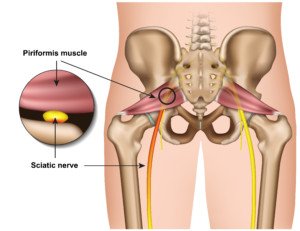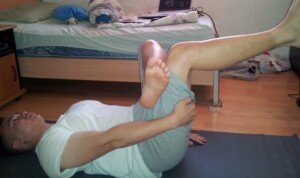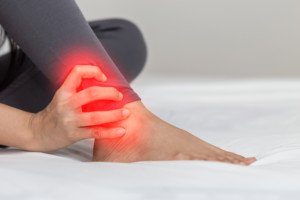Does your outer ankle hurt only after you’ve been sitting for awhile, but then the pain quickly goes away once you’re up and about?
There’s a fix that may work for you.
The pain on the outer portion of my left ankle occurred only after I’d been sitting at my computer. I thought it was just an overworked ankle from exercise.
I didn’t make much of the fact that the pain never occurred while I was watching TV or driving.
And it never came in the middle of exercise (jogging, brisk walking, hill walking, weighted squats, jumping).
However, I thought it might be from jumping because one day it came on particularly strong soon after sitting at my computer, and a short while prior to that, I had done my jumping drills.
I wondered if it was arthritis, but if it was, wouldn’t the pain come on during exercise? And wouldn’t the other ankle also be affected?
I figured that whatever was causing this couldn’t be serious such as a loose bone chip or ligament tear because first of all, running up hills didn’t bring it on; neither did jumping onto a 12-inch exercise stool or trotting up stairs. Nor did 240 jumping jacks in a row. It never hurt during deadlifts or squats.
Secondly, there was no history of an injury, not even a mild twisting of the ankle.
Then one day, as the pain unfolded, it spread to the foot and several inches above the ankle all around the lowest part of my leg.
Because of the “spreading,” and its distinct type of pain, I was confident I knew what the cause of this was.
I then knew why the pain occurred only when I was at my computer and nowhere else while seated.
To solve the problem, I put a head pillow on my computer desk chair, and began sitting on that. This cured the problem instantly!
If you have pain only in the outer portion of an ankle when sitting, I’m not going to tell you what might be causing it. That’s up to your doctor.
I’m only going to describe my thought processes regarding my situation. Two years prior to this, I moved my workstation to the top floor of my townhome, because I had discovered high radon levels on the lower level.
While I was waiting for approval from the HOA for mitigation, I did all my computer work upstairs, sitting on a dining room chair.
Soon after I began this new seating arrangement, my right leg began developing pain. It wasn’t severe, but it was quite unpleasant. It’d go away once I was up and about.
I immediately concluded, “I have sciatica, or more likely, piriformis syndrome.”
My mother has had bouts of sciatica when seated on a particular stool in her home, though it would also strike out of the blue when she was up and about. That’s because the compression of her sciatic nerve originated in the spinal column.

Freepik/brgfx
In my case, the full leg pain predictably kicked in soon after sitting on that dining room chair.
But it was my right leg. I propped my foot up on a chair, and this solved the problem, because it took pressure off my butt and upper leg against the chair.
But I’d never forget the distinct pain—very different from muscle soreness, a pulled or strained muscle or bruising.
Well, when the left outer ankle pain spread to my foot and the bottom of my leg, it was that exact same kind of pain!
I thought, “It’s sciatica! Or–it’s piriformis syndrome! This explains why it happens only when I sit in one particular chair!”

The piriformis muscle runs over the sciatic nerve. medicalstocks
Once I put the pillow on that chair, I stopped getting the pain.
However, I’d been using this chair for many years without any problem.
My theory is that my sciatic nerve was getting pressed upon by my piriformis muscle, which was being subjected to pressure against the chair.
But why only now? I don’t have any great theories. Maybe it’s because over time, the chair has lost some cushiness. Maybe it’s because over time, body parts aren’t as young as they used to be.
If the outer part of your ankle has been hurting lately only while you’re seated, or at any other time, I am NOT recommending that you self-diagnose.
If you find a solution, great. But if you don’t, you should get it checked by your doctor.
Piriformis Stretching Exercises

Freepik.com/yanalya

Kpa1563, CreativeCommons
 Lorra Garrick is a former personal trainer certified by the American Council on Exercise. At Bally Total Fitness she trained clients of all ages for fat loss, muscle building, fitness and improved health.
Lorra Garrick is a former personal trainer certified by the American Council on Exercise. At Bally Total Fitness she trained clients of all ages for fat loss, muscle building, fitness and improved health.
.









































